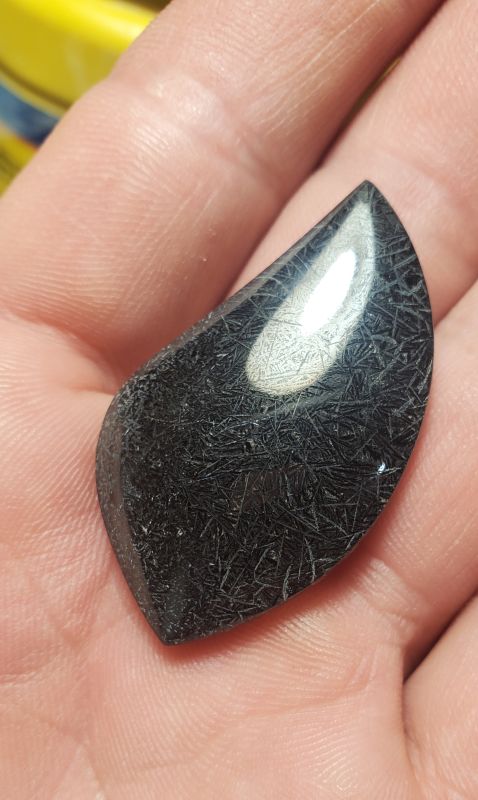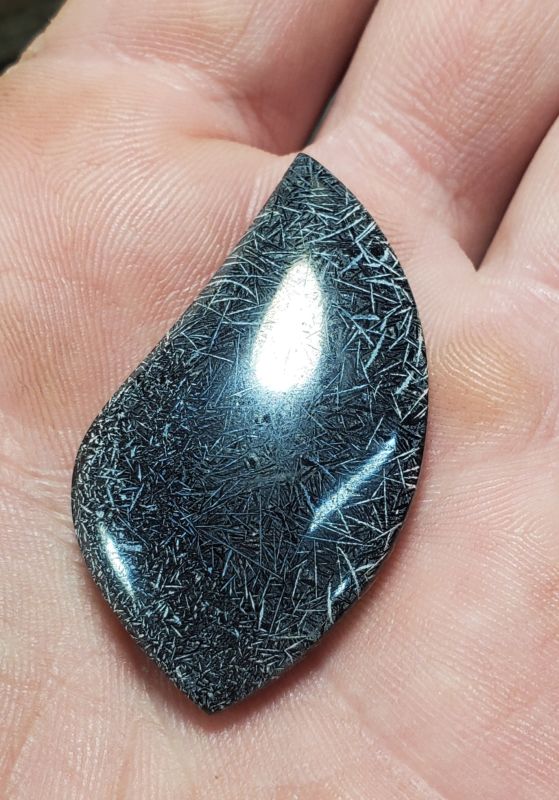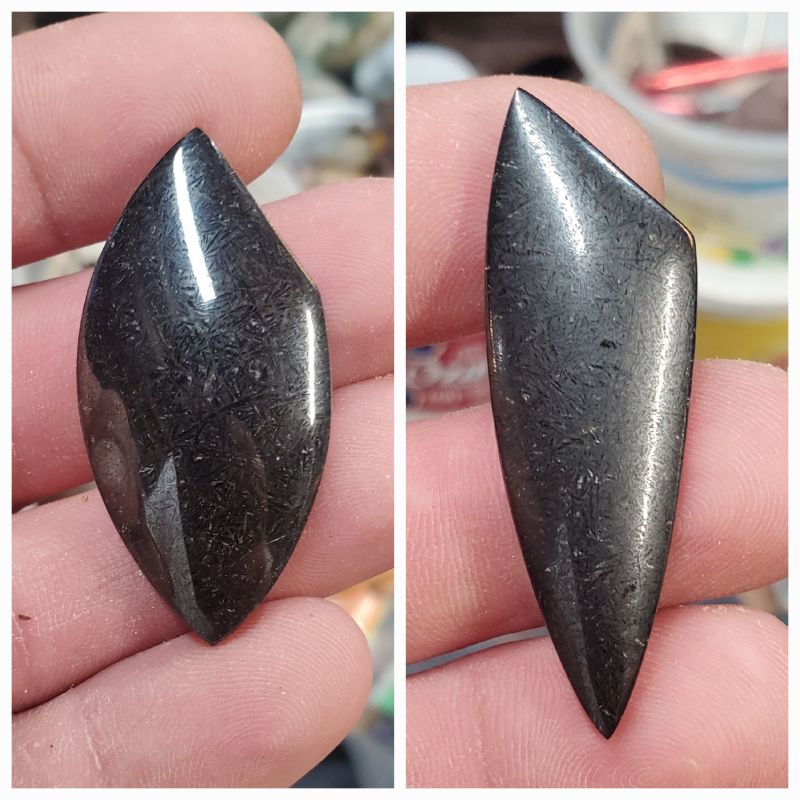oldschoolrocker
fully equipped rock polisher
  
Member since January 2019
Posts: 1,578
|
Post by oldschoolrocker on Mar 22, 2022 23:28:23 GMT -5
...and pretty cool! So a while back I found a rock that was later ID' d here as containing a lot of horneblende. Well I had found this cab in my unfinished pile of cabs and the surface was rusted in places and rough to the touch all over. There appeared to be white crust on all the horneblende needles. I didn't know what to make of it so I re sanded the cab completely and polished and dried it. This was the result after dried and polished -  You can clearly see the horneblende needles but not like I had found the cab. The rust I had found made me assume water was the culprit so I soaked the cab in water for a couple days and pulled it out and let it air dry. This is what the result was-    The cab is now rough to the touch on the polished surface and the needles are covered in a white growth. Looks awesome I think! What's odd is that the backside is unfinished and can see the horneblende needles but there is no white or rough crust on the needles. And I flipped the cab while soaking in water.. anyways, I'm sure with the knowledge of everyone here someone probably has a simple explanation for what happened to the cab but I don't. But would love to know so pls share if so. |
|
|
|
Post by Pat on Mar 22, 2022 23:34:44 GMT -5
I don’t know what it is, but I sure do like it.
|
|
oldschoolrocker
fully equipped rock polisher
  
Member since January 2019
Posts: 1,578
|
Post by oldschoolrocker on Mar 23, 2022 0:03:12 GMT -5
I don’t know what it is, but I sure do like it. Thanks! Another thing I forgot to mention is that I took it out after a day and the white growth was just on the outside of the Domed surface of the cab. Then after soaking it for cpl more days the growth got to where it is in pics. I'm going to soak it a while longer and see if I get any continued growth. |
|
|
|
Post by liveoak on Mar 23, 2022 6:39:04 GMT -5
There must be something water soluble in it,
as it acting like a piece of wood when you wet it, it raises the grain.
It's cool !
|
|
|
|
Post by hummingbirdstones on Mar 23, 2022 10:09:00 GMT -5
I wish I could help you out, but I am clueless about what's going on with that stone. I did look up hornblende and found out it was an amphibole. According to Wikipedia: Amphibole (/ˈæmfəboʊl/) is a group of inosilicate minerals, forming prism or needlelike crystals,[1] composed of double chain SiO 4 tetrahedra, linked at the vertices and generally containing ions of iron and/or magnesium in their structures. Its IMA symbol is Amp.[2] Amphiboles can be green, black, colorless, white, yellow, blue, or brown. The International Mineralogical Association currently classifies amphiboles as a mineral supergroup, within which are two groups and several subgroups.[3] I haven't had enough coffee this morning to even make sense of that.  Your cab is awesome! |
|
|
|
Post by rockjunquie on Mar 23, 2022 10:29:36 GMT -5
I have no clue what that is, but I LOVE it! How weird and cool!
|
|
|
|
Post by liveoak on Mar 23, 2022 11:39:13 GMT -5
So if you sand & polish it again will the cool high lights remain & it just become smooth again ?
Like sanding a piece of wood after the grain is raised .
Curious
|
|
|
|
Post by 1dave on Mar 23, 2022 11:54:39 GMT -5
I know exactly what happened!
You know it errr, harrump, you know, I mean to say it rather umm kind of you know, and like that.
Back to reality, when you get it as you like it best, I wonder if there is some kind of protective coat?
|
|
Brian
fully equipped rock polisher
  
Member since July 2020
Posts: 1,512
|
Post by Brian on Mar 23, 2022 12:26:57 GMT -5
I looked up the chemical formula for horneblende and there are a few possibilities.
It is described as calcium rich. Calcium could have definitely resulted in some scale after soaking in water for a few days.
There is also aluminum, magnesium and iron present. The iron explains the rust, but the white portions could be oxidation of either aluminum or magnesium.
If it has significant texture, I’d lean towards the calcium being the culprit, but if it is just a light texture, it may be oxidation of the aluminum or magnesium.
I’m pretty sure my chemistry degree has long since expired from lack of use, but sometimes I remember enough to be dangerous.
|
|
oldschoolrocker
fully equipped rock polisher
  
Member since January 2019
Posts: 1,578
|
Post by oldschoolrocker on Mar 23, 2022 12:52:12 GMT -5
So if you sand & polish it again will the cool high lights remain & it just become smooth again ? Like sanding a piece of wood after the grain is raised . Curious No the highlights disappear when sand and polish again. And no highlights appeared on the other cabs I finished that stayed dry. |
|
oldschoolrocker
fully equipped rock polisher
  
Member since January 2019
Posts: 1,578
|
Post by oldschoolrocker on Mar 23, 2022 12:52:32 GMT -5
I wish I could help you out, but I am clueless about what's going on with that stone. I did look up hornblende and found out it was an amphibole. According to Wikipedia: Amphibole (/ˈæmfəboʊl/) is a group of inosilicate minerals, forming prism or needlelike crystals,[1] composed of double chain SiO 4 tetrahedra, linked at the vertices and generally containing ions of iron and/or magnesium in their structures. Its IMA symbol is Amp.[2] Amphiboles can be green, black, colorless, white, yellow, blue, or brown. The International Mineralogical Association currently classifies amphiboles as a mineral supergroup, within which are two groups and several subgroups.[3] I haven't had enough coffee this morning to even make sense of that.  Your cab is awesome! Thank you and thanks for the info! |
|
oldschoolrocker
fully equipped rock polisher
  
Member since January 2019
Posts: 1,578
|
Post by oldschoolrocker on Mar 23, 2022 12:53:21 GMT -5
I have no clue what that is, but I LOVE it! How weird and cool! Thank you! Definitely a weird one! |
|
oldschoolrocker
fully equipped rock polisher
  
Member since January 2019
Posts: 1,578
|
Post by oldschoolrocker on Mar 23, 2022 12:56:07 GMT -5
I know exactly what happened! You know it errr, harrump, you know, I mean to say it rather umm kind of you know, and like that. Back to reality, when you get it as you like it best, I wonder if there is some kind of protective coat? I was wondering myself about how to preserve the highlights. Not sure how easily they come off since I have been handling it delicately. But since I know how to reproduce the results il have to test its durability with normal handling and see. |
|
|
|
Post by jasoninsd on Mar 23, 2022 14:25:55 GMT -5
This is amazing! I thought the piece was gorgeous in the first photo...but it's absolutely lights out when the "reaction" occurs! I'll definitely be watching to see if there's a way to preserve the whitening... Thanks for posting this!  |
|
oldschoolrocker
fully equipped rock polisher
  
Member since January 2019
Posts: 1,578
|
Post by oldschoolrocker on Mar 23, 2022 14:38:07 GMT -5
I looked up the chemical formula for horneblende and there are a few possibilities. It is described as calcium rich. Calcium could have definitely resulted in some scale after soaking in water for a few days. There is also aluminum, magnesium and iron present. The iron explains the rust, but the white portions could be oxidation of either aluminum or magnesium. If it has significant texture, I’d lean towards the calcium being the culprit, but if it is just a light texture, it may be oxidation of the aluminum or magnesium. I’m pretty sure my chemistry degree has long since expired from lack of use, but sometimes I remember enough to be dangerous. Ya know now that I think about it I did just use tap water so calcium could definitely be the culprit. Il try some spring water and see. The texture Is fairly significant compared to the polished surface it once was but not super rough overall. However, the way it was when found it with rust it was pretty heavily textured. So would seem likely calcium deposits. Thanks for the info! I knew there are too many good minds on here for someone not to know! |
|
oldschoolrocker
fully equipped rock polisher
  
Member since January 2019
Posts: 1,578
|
Post by oldschoolrocker on Mar 23, 2022 14:40:07 GMT -5
This is amazing! I thought the piece was gorgeous in the first photo...but it's absolutely lights out when the "reaction" occurs! I'll definitely be watching to see if there's a way to preserve the whitening... Thanks for posting this!  Thanks, glad you enjoyed it. Il update with preservation efforts for sure. I'm have to dig up my other cabs of this material and do some more and see if can get same reaction on all of the pieces. |
|
|
|
Post by jasoninsd on Mar 23, 2022 14:42:39 GMT -5
This is amazing! I thought the piece was gorgeous in the first photo...but it's absolutely lights out when the "reaction" occurs! I'll definitely be watching to see if there's a way to preserve the whitening... Thanks for posting this!  Thanks, glad you enjoyed it. Il update with preservation efforts for sure. I'm have to dig up my other cabs of this material and do some more and see if can get same reaction on all of the pieces. I'm not saying you should...but it just dawned on me...I wonder what would happen if they were soaked in dyed water...?? |
|
oldschoolrocker
fully equipped rock polisher
  
Member since January 2019
Posts: 1,578
|
Post by oldschoolrocker on Mar 23, 2022 15:24:38 GMT -5
Ah, you are onto something there! I've got a couple cabs of it so I'm definitely doing some experiments with them. Besides, worst case I just re sand and polish them. For sure going to experiment with colored water!
|
|
electrocutus
spending too much on rocks
 
Member since October 2020
Posts: 341 
|
Post by electrocutus on Mar 24, 2022 9:26:07 GMT -5
It looks extermely cool!
|
|
oldschoolrocker
fully equipped rock polisher
  
Member since January 2019
Posts: 1,578
|
Post by oldschoolrocker on May 6, 2022 18:29:04 GMT -5
Ok so a bit of an update on this material. I put two other cabs of it in cup with bottled spring water for around a week. These are the results.... First. The two cabs. One on left is semi polished and one on right i stopped sanding at 600 wheel.  After a day there were bubbles all over both cabs which over time formed into yellow blobs.   The final result after rubbing off the yellow o stuff with my thumb and some water.  The yellow stuff comes off with minimal effort but the raised hornblende doesn't rub off. The one on right has bigger growth than left one. I'm assuming because wasn't polished like other one. Pretty interesting stuff. Going to sand down one and try it in some colored water like jasoninsd suggested! |
|


























